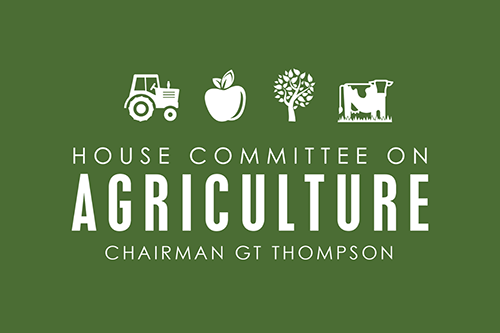
NCBA CLUSA hosted leaders from the cooperative and agricultural communities on Friday, March 12 for a discussion on critical provisions within the American Rescue Plan that present opportunities for cooperatives, including historic investments in small businesses and socially disadvantaged farmers.
Moderated by NCBA CLUSA president and CEO Doug O’Brien, the conversation started with framing from Brandon Honeycutt, Senior Agriculture Policy Advisor for U.S. Senator Rev. Raphael Warnock (D-GA). Sen. Warnock, who campaigned on his support for farmers of color and agriculture in Georgia, spearheaded the inclusion of his Emergency Relief for Farmers of Color Act in the $1.9 trillion American Rescue Plan signed into law last week.
Importantly, Honeycutt said, that legislation seeks to address longstanding inequities in agriculture by providing $4 billion in debt forgiveness for Black producers and producers of color who faced decades of institutional discrimination by the U.S. Department of Agriculture (USDA). More recently, the disproportionate impacts of COVID-19 have delivered another blow to these communities. The legislation provides an additional $1 billion for capacity building and technical assistance, including cooperative development.
Whether or not the investment is successful hinges largely on the ability of implementers to earn the trust of Black farmers, said Cornelius Blanding, Executive Director of the Federation of Southern Cooperatives/Land Assistance Fund. “As we’re looking at this $4 billion in debt relief, how that’s distributed matters,” Blanding said, urging that care should be taken to not only be equitable, but also transparent. “Trust is going to be important,” he added.
“As we’re looking at this $4 billion in debt relief, how that’s distributed matters. Trust is going to be important.” – Cornelius Blanding, Federation of Southern Cooperatives/Land Assistance Fund
The Black farming community is still enduring the effects of “rampant and historical discrimination,” Blanding said. Of the 3.4 million farmers in the U.S. today, fewer than 45,000 are Black, according to the USDA—down from 1 million a century ago. Black land ownership also peaked in the early 20th century at 16-19 million acres, according to the Census of Agriculture. A century later, 90 percent of that land has been lost. Today, most Black farmers operate on less than 100 acres, Blanding said.
Heirs’ property further adds to the persistent challenges Black farmers face. Created when a landowner dies without a will or other form of estate plan to transfer land ownership, heirs’ property leaves Black farming families without a clear title to the land they own, making it difficult to build and maintain wealth. Black farmers also face issues around access to credit and achieving scale. That’s where cooperatives come in. “Scale is best achieved by organizing co-ops, something we at the Federation have been doing for 54 years,” Blanding said.
The American Rescue Plan provides “exciting opportunities for cooperatives,” Blanding said, citing a provision that would create and fund a new financial institution cooperatively owned by Black farmers “so they can lend to themselves,” similar to the existing Farm Credit System. Another provision would prioritize land access for new, beginning and next-generation farmers, addressing the issue of heirs’ property that currently complicates succession planning.
While no piece of legislation could right the cumulative effects of discrimination that Black farmers have endured, Blanding said, the American Rescue Plan is a long-overdue recognition of past wrongs.
While no piece of legislation could right the cumulative effects of discrimination that Black farmers have endured, Blanding said, the American Rescue Plan is a long-overdue recognition of past wrongs.
“It also gives us the opportunity to hit the ‘reset’ button as we come out of this pandemic,” he said. “It’s an opportunity to reset our food system, reset the mechanisms we have in place to protect our environment and really start imagining what we want this system to look like.”
Many of the issues faced by America’s Black farming community are shared by Native farmers and ranchers, said Janie Hipp, CEO of the Native American Agriculture Fund (NAAF) and a citizen of the Chickasaw nation. Opportunities overlap, too, like the potential for cooperative lending systems, she said.
The two communities also share a reliance on rural infrastructure—or lack thereof, Hipp said. “The cooperative model is something we all need to deeply explore and think about how it can impact folks who don’t live in or near urban centers, because it’s getting harder and harder to access infrastructure and resources that folks need to be successful,” she said, citing broadband and its critical role in access to markets as an example. NAAF’s recent report, Reimagining Native Food Economies, embeds cooperatives as partners in developing Native American agriculture and food systems.
In August, NCBA CLUSA and the Cooperative Development Foundation will partner with NAAF to host a webinar series called “Cooperating to Enhance Native American Food Economies.”
The American Rescue Plan, Hipp said, “lays the foundation for coming out of the pandemic in a new way,” addressing many of the longstanding issues that have impacted both Native American and Black farming and ranching communities for decades. The legislation’s “substantial” tribal investments are promising, she said; so too are the broader investments in utilities and infrastructure that will ultimately help native communities.
“We can’t go back to the way it was,” she said. “Let’s get it right this time.”
“We can’t go back to the way it was. Let’s get it right this time.” – Janie Hipp, Native American Agriculture Fund
NCBA CLUSA’s Director of Government Relations, Kate LaTour, capped Friday’s webinar with a rundown of small business provisions included in the “deeply needed” American Rescue Plan.
- Economic Injury Disaster Loan (EIDL) and Grant Program – The American Rescue Plan provides an additional $15 billion for the EIDL Targeted Advance.
- Paycheck Protection Program (PPP) – the American Rescue Plan provides an additional $7.25 billion for PPP, available for both first draw and second draw loans.
- Restaurant Revitalization Fund – entities eligible to receive Restaurant Revitalization Fund grants include food cooperatives
- State Small Business Credit Initiative – in revitalizing this initiative, the American Rescue Plan appropriates $10 billion to help states and tribal governments leverage up to $100 billion in low-cost financing and technical assistance.
- Childcare – the American Rescue Plan makes significant investments in childcare stabilization
- Broadband – the American Rescue Plan establishes a $7.2 billion emergency connectivity fund at the FCC
- Global COVID-19 Response – the American Rescue Plan provides $11 billion toward the global response to COVID-19, largely to mitigate public health impacts, but also to invest in building food security and achieving economic stability.
Because the Paycheck Protection Program ends on March 31, LaTour urged attendees to reach out to their lenders as soon as possible.
As the investments outlined in the American Rescue Plan move toward implementation, the best thing cooperative leaders can do is work closely with USDA and government agencies, Honeycutt said. “Providing recommendations that a strong coalition of stakeholders can rally around will give Secretary Vilsack a really clear and solid path forward on how to spend this money in a smart, strategic way,” he said.
“Providing recommendations that a strong coalition of stakeholders can rally around will give Secretary Vilsack a really clear and solid path forward on how to spend this money in a smart, strategic way.” – Brandon Honeycutt, Office of Senator Rev. Raphael Warnock
“It’s a critical moment for the cooperative community to be fully engaged,” O’Brien added.


